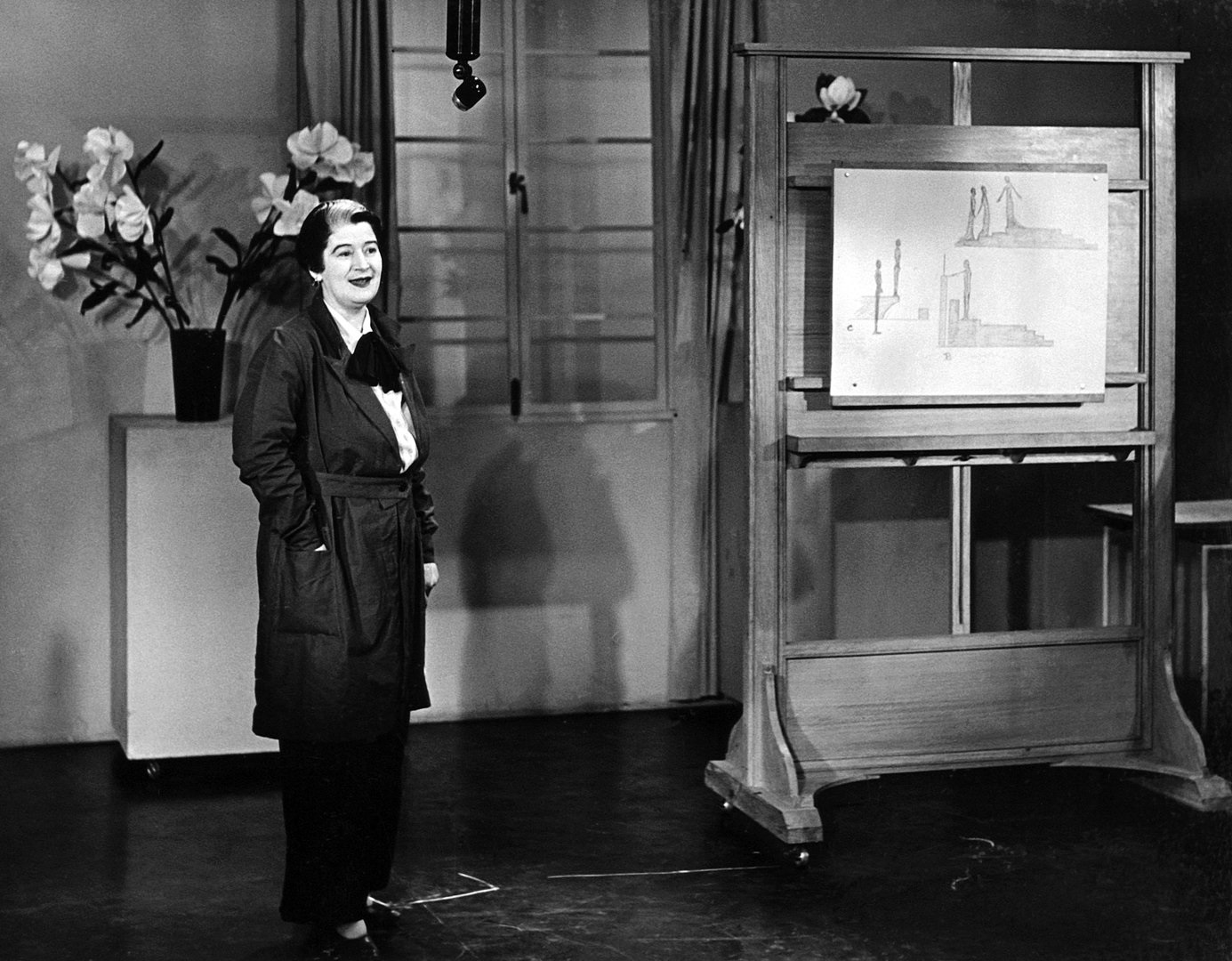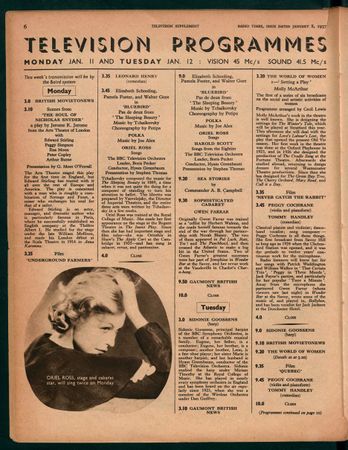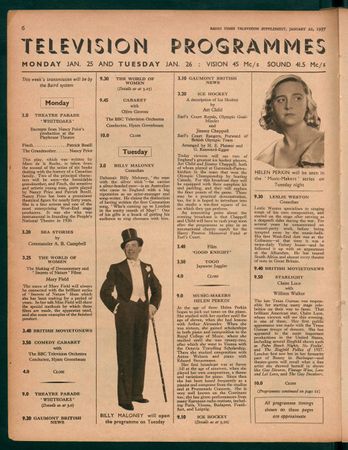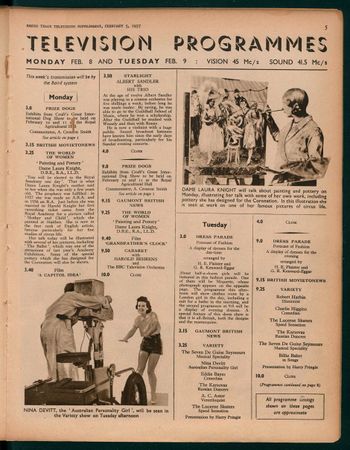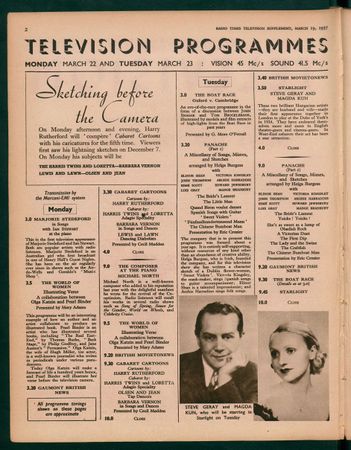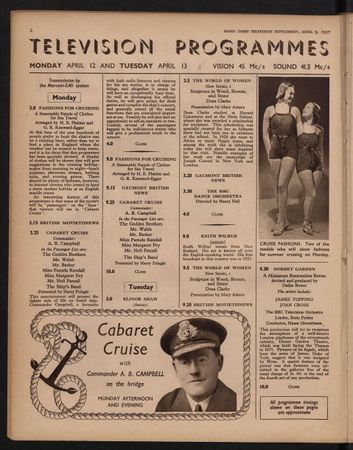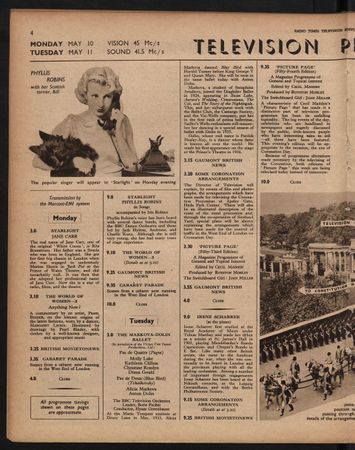The World of Women (lost early BBC talk show; 1937)
The World of Women is an early BBC Television Service talk show. Broadcast in 1937, it was one of the first television programs to focus exclusively on women, with the premise involving various women discussing their social and/or artistic activities. Additionally, it was one of the first television shows to receive a second series.
Background
The program was presented by Mary Adams, who is credited as the first female television producer.[1] Initially, a six-part series, The World of Women's premise was to showcase the careers of notable women.[2][3] Episodes were broadcast on roughly a fortnightly basis.
The Episodes
The first episode was broadcast on January 12th, 1937, featuring theatre costume and set designer Molly MacArthur.[2][3] According to issue 693 of Radio Times, McArthur began theatre work in 1923 at the Oxford Playhouse, and prior to the broadcast, was designing the settings for The Winter's Tale to be presented at Stratford later in 1937.[2][3] In the 15-minute broadcast, she discussed how the settings for the play Love's Labour's Lost was provided for the Old Vic.[4][2][3] The second episode aired on 25th January, and featured Mary Field, the producer behind the Secrets of Nature documentaries.[5][6][7] Field notably had no training in science, but would ultimately succeed in providing key film direction that combined education with instruction.[5] In the episode, she showcased the techniques and apparatuses used for the films, while also allowing some fragments of the final product to be shown.[6][7]
Episode 3, broadcast on 8th February,[8][9] featured Dame Laura Knight, whose skill in painting and pottery allowed her to become only the second woman to be granted permanent full membership of the Royal Academy, in 1936.[10] She had already been made a Dame in 1929,[10] and in modern times is cited for allowing greater recognition for female artists, considering that the British art establishment comprised mainly of men.[11][10] In the episode, she discussed a few of her key pictures, including The Ballet, which featured in the 1936 Academy Exhibition.[8][9] Knight also revealed some of the pottery used for the Coronation of King George VI and Queen Elizabeth.[8][9] The fourth known episode, broadcast on 8th May,[12][13] showcased the talents of Lady Kennet, a sculptor, who the Oxford Dictionary of National Biography deemed "the most significant and prolific British women sculptor before Barbara Hepworth".[14] The episode featured her showcasing some of her sculptured busts and the processes of creating the models.[12][13]
Airing on 22nd March, the fifth known episode was a collaboration between the poet Olga Katzin, and the illustrator Pearl Binder.[15][16] Katzin succeeded within the world of journalism, utilising pseudonyms to write periodicals in such newspapers as The Herald, The Manchester Guardian, and Time and Tide.[17] Meanwhile, Binder illustrated various 1930s and classic stories, including the 1817 Jane Austen novel Persuasion.[18][15][16] In the episode, Katzin would provide poetry detailing "life a hundred years hence", with Binder illustrating each verse in front of the television cameras.[15][16]
Series 2
The details of the sixth episode were not detailed in any Radio Times issue, but the show proved popular enough for a second series, which started airing on April 13th.[19][20] Episode 1 of the new series featured Dora Clarke, a sculptor and wood carver who was awarded a scholarship for sculpture at Harvard Commerce and at the Slade School, the first person known to have been awarded such a scholarship at the school.[19][20] She was most known for her work regarding the memorials of Joseph Conrad situation in New York and London, as well as the promotion of African art.[21] This included living in Kenya in 1927 for a year, where her drawings helped her craft wood carvings and bronze tribal figures when she returned to London.[19][20] She discussed this work within the episode.[19][20] Episode 2 was not documented in any Radio Times issue, but the third, broadcast on 10th May, saw Binder discuss and illustrate the origins of the then-latest fashions, modelled by dancer Margaret Leona.[22][23]
Availability
Like all early television transmissions, the episodes of The World of Women were televised live and there were limited viable means of recording television prior to the Second World War, with recording seldom having occurred until videotape was perfected in the late-1950s.[24] Thus, all footage of The World of Women is likely permanently missing. Nevertheless, a photo of MacArthur on the show is publicly accessible,[25] as are Radio Times issues that helped to document the two series.[3][7][9][13][16][20][23]
Gallery
Images
See Also
Early BBC Television
- Alexandra Palace's wartime television demonstrations (lost footage of private television transmissions; 1943, 1945)
- An Inspector Calls (lost television adaptation of play; 1948)
- Ann and Harold (lost early BBC drama television series; 1938)
- BBC Election Night (lost coverage of British general elections; 1950-1951)
- The Care of Your Car (lost early BBC motoring show; 1947)
- Cook's Night Out (lost early BBC cooking show; 1937)
- Craftsmen at Work (lost early BBC documentary show; 1938, 1946)
- Dish of the Month (lost early BBC cooking show; 1937)
- First Aid (lost early BBC medical show; 1937)
- Foundations of Cookery (lost early BBC cooking show; 1939)
- Marcel Boulestin television shorts (lost early BBC programs; 1937-1939)
- Masks through the Ages (lost early BBC history talk show; 1937)
- Opening of the BBC Television Service (partially found coverage of inaugural day of high-definition television service; 1936)
- The Orchestra and its Instruments (lost early BBC music talk show; 1937)
- RCA recording of BBC Television Service (found footage of pre-Second World War BBC television broadcast; 1938)
- Sea Stories (lost early BBC talk show; 1936-1937)
- Spelling Bee (lost early BBC game show; 1938)
- Telecrime (lost early BBC crime drama; 1938-1939; 1946)
- The Wasp's Nest (lost early BBC television adaptation of Agatha Christie short story; 1937)
- Weaponless Self-Defence (lost early ju-jitsu television program; 1936-1937)
Early BBC Sports Television
- 1931 Epsom Derby (lost televised footage of horse racing event; 1931)
- 1937 FA Cup Final (partially found footage of football match; 1937)
- 1937 International Imperial Trophy Race (lost footage of motor race; 1937)
- 1937 Wimbledon Championships (partially found footage of tennis tournament; 1937)
- 1938 Ashes Series (partially found footage of international test cricket match; 1938)
- 1938 FA Cup Final (partially found footage of football match; 1938)
- 1939 FA Cup Final (partially found footage of football match; 1939)
- 1947 FA Cup Final (partially found footage of football match; 1947)
- 1953 British Grand Prix (partially found footage of Formula One race; 1953)
- 1955 Scottish Cup Final (partially found footage of football match; 1955)
- Archery (lost early televised toxophily; 1937-1938)
- Arsenal 7-1 Hibernian (lost footage of charity football match; 1952)
- Arsenal vs Arsenal Reserves (lost footage of early BBC televised football match; 1937)
- Barnet 3-2 Wealdstone (lost footage of Athenian League football match; 1946)
- The Boat Race 1938 (partially found footage of rowing race; 1938)
- Catch-As-Catch-Can Wrestling (lost early BBC televised professional wrestling matches; 1938-1939; 1946-1947)
- Charlton Athletic 1-0 Blackburn Rovers (lost footage of FA Cup match; 1947)
- Darts and Shove Ha'penny (lost early BBC televised darts matches; 1936-1939)
- England 0-1 Scotland (partially found international football match; 1938)
- England 1-1 Scotland (partially found footage of international football match; 1947)
- England 16-21 Scotland (partially found footage of rugby match; 1938)
- England 3-0 France (partially found footage of international football match; 1947)
- England 3-0 Rest of Europe (partially found footage of international football match; 1938)
- Falkirk 3-2 Newcastle United (lost footage of football match; 1953)
- Horace Lindrum vs Willie Smith (lost footage of televised snooker; 1937)
- Scottish Universities 1-1 English Universities (lost footage of international football match; 1952)
- Woods and Jack (lost early televised lawn bowls; 1937; 1946)
External Link
References
- ↑ BBC crediting Mary Adams as the first female television producer. Retrieved 27th Jan '22
- ↑ 2.0 2.1 2.2 2.3 BBC Genome archive of Radio Times issues detailing the Molly MacArthur episode. Retrieved 27th Jan '22
- ↑ 3.0 3.1 3.2 3.3 3.4 Issue 693 of Radio Times listing the Molly MacArthur episode. Retrieved 27th Jan '22
- ↑ Old Vic Saga detailing the various set designs MacArthur made for various theatre plays. Retrieved 27th Jan '22
- ↑ 5.0 5.1 Secrets of Nature detailing Mary Field's contributions to the documentaries. Retrieved 27th Jan '22
- ↑ 6.0 6.1 BBC Genome archive of Radio Times issues detailing the Mary Field episode. Retrieved 27th Jan '22
- ↑ 7.0 7.1 7.2 Issue 695 of Radio Times listing the Mary Field episode. Retrieved 27th Jan '22
- ↑ 8.0 8.1 8.2 BBC Genome archive of Radio Times issues detailing the Dame Laura Knight episode. Retrieved 27th Jan '22
- ↑ 9.0 9.1 9.2 9.3 Issue 697 of Radio Times listing the Dame Laura Knight episode. Retrieved 27th Jan '22
- ↑ 10.0 10.1 10.2 The Guardian detailing the life and career of Dame Laura Knight. Retrieved 27th Jan '22
- ↑ Laura Knight Portraits detailing Knight's contributions in the British art establishment. Retrieved 27th Jan '22
- ↑ 12.0 12.1 BBC Genome archive of Radio Times issues detailing the Lady Kennet episode. Retrieved 27th Jan '22
- ↑ 13.0 13.1 13.2 Issue 701 of Radio Times listing the Lady Kennet episode. Retrieved 27th Jan '22
- ↑ Oxford Dictionary of National Biography detailing the life and contributions of Lady Kennet. Retrieved 27th Jan '22
- ↑ 15.0 15.1 15.2 BBC Genome archive of Radio Times issues detailing the Olga Katzin and Pearl Binder episode. Retrieved 27th Jan '22
- ↑ 16.0 16.1 16.2 16.3 Issue 703 of Radio Times listing the Olga Katzin and Pearl Binder episode. Retrieved 27th Jan '22
- ↑ New Statesman Competitions and New Statesman satirical poems: a history detailing the career of Olga Katzin. Retrieved 27th Jan '22
- ↑ Spitalfields Life detailing the life and career of Pearl Binder. Retrieved 27th Jan '22
- ↑ 19.0 19.1 19.2 19.3 BBC Genome archive of Radio Times issues detailing the Dora Clarke episode. Retrieved 27th Jan '22
- ↑ 20.0 20.1 20.2 20.3 20.4 Issue 706 of Radio Times listing the Dora Clarke episode. Retrieved 27th Jan '22
- ↑ Mapping the Practice and Profession of Sculpture in Britain & Ireland 1851-1951 detailing the life and career of Dora Clarke. Retrieved 27th Jan '22
- ↑ BBC Genome archive of Radio Times issues detailing the Pearl Binder and Margaret Leona episode. Retrieved 27th Jan '22
- ↑ 23.0 23.1 Issue 710 of Radio Times listing the Pearl Binder and Margaret Leona episode. Retrieved 27th Jan '22
- ↑ Web Archive article discussing how most early television is missing due to a lack of direct recording of television. Retrieved 27th Jan '22
- ↑ BBC Archive providing the photo of Molly McArthur on the show. Retrieved 27th Jan '22
